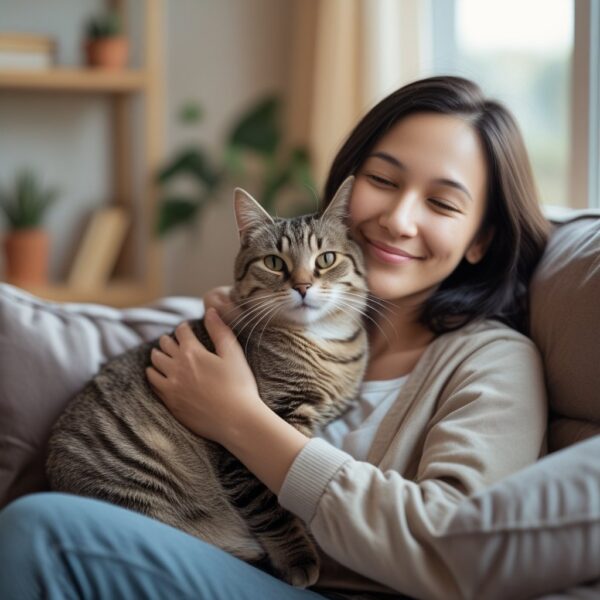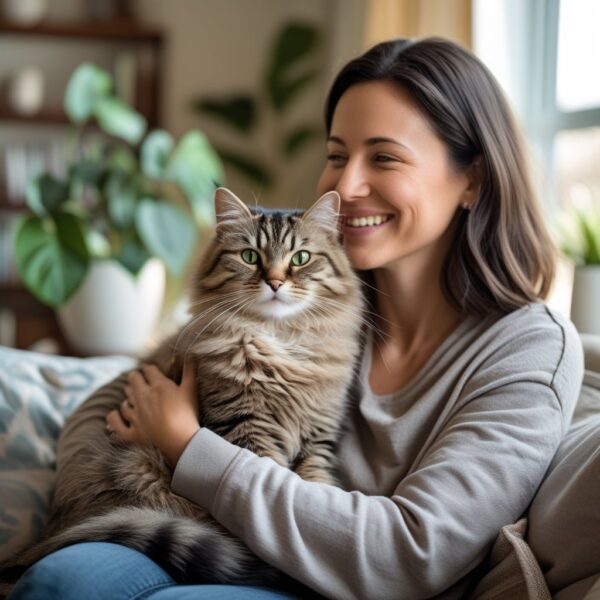
Hugging Your Cat: Understanding Cat Comfort
Do cats like being hugged? While some cats enjoy close physical contact and may even seek it out, others prefer their space and shy away from being handled. Hugging, a common way humans show affection, can feel overwhelming or restrictive to many cats. Their reaction largely depends on individual temperament, past experiences, and their bond with the person attempting the hug.
It’s essential to recognize that a majority of cats do not naturally understand hugs as a form of affection. They might tolerate it, especially if done gently, but prolonged holding or tight embraces can cause stress or discomfort. Understanding your cat’s body language and respecting their boundaries is crucial for ensuring their comfort and happiness.
Key Takeaways
- Cats vary in their reactions to hugs.
- Overwhelming most cats with hugs can cause stress.
- Respect boundaries and watch for positive responses.

Do Cats Like Being Hugged?
Cats have unique ways of showing affection, and their attitudes toward being hugged vary. While some cats may tolerate or even enjoy hugs, others strongly dislike the experience, which is often influenced by their individual personality and past interactions with humans.
Understanding Cat Affection and Hugging your cat
Cats express affection differently than humans. Instead of physical hugging, cats often communicate their love through actions such as gentle head butts, purring, or rubbing against their owner’s legs. These behaviors indicate they feel safe and happy around their human companions.
Factors such as their upbringing and level of socialization can play a role. Cats raised in environments with positive physical touch may be more open to close physical interactions, while others may prefer affection at a distance.
How Cats Exhibit Comfort and Trust
When a cat feels secure, they display a range of relaxed behaviors. Common signs include:
- Slow blinking: When a cat slowly blinks at their feline friend or owner, it’s often considered a sign of trust and affection.
- Lying on their back: Exposing their belly shows vulnerability, which suggests they feel comfortable.
- Initiating contact: Cats who nuzzle, sit close, or curl up next to someone are showing they enjoy their company.
Cats that seek out physical closeness may be more likely to enjoy gentle hugs. However, even in these cases, the cat’s body language should be observed to ensure they remain comfortable.
Common Signs Cats Dislike Hugging
Not all cats find hugging pleasant, and they often communicate this with clear signals. Cat guardians should watch for these signs to avoid unwanted stress:
- Tensed body: A stiff posture or an arched back may indicate discomfort.
- Ears pinned back: Flattened ears suggest irritation or fear.
- Attempts to escape: Struggling or pushing away with their paws shows they want to be set free.
- Growling or hissing: Vocalizations like these are strong indicators of distress.
Forcing hugs on a cat that dislikes them can harm the bond between feline friend and guardian. It’s vital to respect their boundaries and find other ways to share affection.
Types of Cats and Their Reactions to Hugs
Cats vary widely in how they react to hugs, depending on their breed, age, and individual personality. While some cats may enjoy close physical affection, others may find it stressful or unwelcome.
Breed Differences in Hug Acceptance
Certain breeds are more comfortable with physical contact than others. Ragdolls, known for their affectionate and relaxed nature, often tolerate or even enjoy hugs. They are sometimes described as “dog-like” for their love of human interaction. In contrast, Sphynx cats, while highly social and people-oriented, may prefer cuddling over restrictive hugging due to their sensitive skin.
Breeds that generally accept hugs:
- Ragdoll
- Burmese
- Maine Coon
Breeds that may be less inclined to enjoy hugging:
- Bengal
- Abyssinian
- Siamese
Understanding breed-specific traits can help gauge how a cat may respond to hugging.
Kitten vs. Adult Cat Behavior
Kittens are usually more open to physical interaction due to their playful and curious nature. Their high energy levels and frequent handling during early development make them more adaptable to hugs. However, they may wriggle or show signs of discomfort quickly if restrained for too long.
Adult cats, on the other hand, tend to have more defined preferences. A mature Ragdoll might appreciate a gentle hug, while a high-energy cat like a Bengal could be less tolerant. Observing the cat’s body language, such as attempts to escape or twitching tails, can provide clues about comfort levels.
The Influence of Cat Personality
Every cat has a unique personality that shapes its reaction to hugs. Cats with a calm and trusting nature—often seen in affectionate breeds like Ragdolls—are more likely to enjoy hugging. Playful and energetic cats like Bengals may prefer active engagement such as toys or games instead.
Cats with a more independent or timid disposition might resist hugs and display signs of agitation, such as restlessness, tail swishes, or flattened ears. For these cats, alternative ways of showing affection, such as gentle stroking or providing treats, may work better.
Focusing on the cat’s personal preferences is key, as even within the same breed, reactions to hugs can vary significantly.

Safe Ways to Show Affection to Your Feline Friend
Cats may not always enjoy hugs, but there are many other ways to express love and bond with them. Understanding their body language and preferences is key to ensuring they feel secure and happy.
The Importance of Gentle Touching
Cats respond well to soft, deliberate strokes instead of rough or abrupt motions. Using an open hand, pet them along their back, head, and under the chin—areas they usually enjoy. Avoid patting or touching their belly unless the cat explicitly shows comfort with this.
For scratching, invest in grooming gloves or a soft brush, as many cats enjoy being gently combed. This doesn’t only show affection but also helps maintain a healthy coat.
Alternatives to Hugging your Cat
Instead of hugging, consider:
- Rubbing: Allow the cat to initiate by rubbing its head or body against you. This is a natural way cats show love.
- Cuddling on their terms: Let them sit on your lap or beside you if they choose to.
- Interactive play: Use wand toys or balls to engage with them in a way they find exciting.
You can also create cozy spaces like cat towers, tunnels, or beds for them to relax and feel cared for. These gestures show affection without overwhelming them.
Recognizing When Your Cat Wants Space
Pay attention to cues like twitching tails, flattened ears, or attempts to move away. These signs indicate a desire for space. Forcing interaction during these times can stress your cat.
Give them freedom to approach you when they feel comfortable. Being patient and respecting their boundaries strengthens trust between cat and guardian.
Signs Your Cat Enjoys Cuddling
Cats show their comfort and affection during cuddling in various ways, such as relaxed body language, soothing vocalizations, and their particular preferences for physical touch. Observing these behaviors can help identify whether your cat enjoys being close and affectionate.
Body Language That Signals Comfort
A cat’s body language provides important clues about their feelings during cuddling. Relaxed posture is a key sign; a cat that stretches out, curls up against you, or calmly sleeps in your arms shows they feel safe. Look for signs like slow blinks, which are a cat’s way of displaying affection and trust.
If the cat rubs their head or body against you during cuddling, this is a clear signal of comfort and bonding. Such behavior is often a way for cats to share their scent, marking you as someone they trust and view as part of their space.
Purring and Other Vocal Cues
Purring is frequently associated with contentment, and it can be a strong indicator that your cat is enjoying the cuddling session. While some cats purr for various reasons, a steady, soothing purr during physical contact usually signals relaxation.
Other vocal signs of enjoyment during cuddling might include soft chirps or trills, which cats often use as friendly communication. Avoidance signals, like growling or hissing, are clear indications that the cat is not comfortable, and cuddling should be paused or stopped.
Physical Contact Preferences
Cats often have specific preferences for how and where they like to be touched during cuddling. Many enjoy gentle stroking along their head, cheeks, or chin, as these are areas rich in scent glands. Scratches behind the ears may also be welcomed.
If your cat leans into the hug, nudges you with their head, or remains still without trying to escape, these are signs they may enjoy physical closeness. On the other hand, struggles, squirming, or attempts to move away suggest the cat is uncomfortable and should not be forced to cuddle.
Potential Risks and When to Avoid Hugging your cat
Hugging a cat can sometimes lead to stress or discomfort for the animal and may even result in defensive actions such as scratching or biting. Understanding when a hug is inappropriate and knowing when to consult a veterinarian are key for cat owners to ensure their pet’s well-being.
Stress and Anxiety in Felines
Cats are naturally independent and can react negatively to being held tightly. A hug may feel confining or threatening, especially for cats not accustomed to extended contact. Signs of stress may include:
- Flattened ears
- Dilated pupils
- Rapid breathing
- Attempting to escape
Frequent stressful interactions, such as forced hugging, can harm the cat’s emotional health over time.
Recognizing Defensive Behaviors
Cats that feel cornered or stressed may display defensive behaviors. Owners should watch for warning signs like hissing, growling, or swiping with their claws. These behaviors indicate a clear desire to be left alone. Forcing interaction at this point can result in scratches or bites, which could lead to physical injury for the guardian.
When to Seek Advice From a Veterinarian
If a cat shows frequent aggression or severe anxiety around physical touch, it may indicate an underlying health issue. A veterinarian can assess whether pain, illness, or other medical conditions are contributing to the behavior. Seeking professional advice ensures that both the cat and guardian can maintain a healthy and safe relationship.